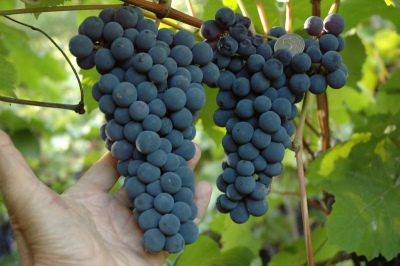
- Authors: A.I. Potapenko
- Appointment: universal
- Berry color: purple
- Taste: harmonious, sweet, with pleasant sourness
- Ripening period: early
- Ripening period, days: 110
- Frost resistance, ° C: -40
- Name synonyms: Odin, Amurskiy 7
- Bunch weight, g: up to 1000
- Yield: up to 80-100 kg per bush
The Amur Breakthrough grape is a fairly popular variety with an interesting history of origin. Its "parents" are frost-resistant and prolific varieties, from which the Amur breakthrough took only the best qualities. Its characteristics are unique, for which the plant is loved by many gardeners.
Breeding history
The variety appeared thanks to A.I. Potapenko, who dared to an unusual experiment. He crossed hardy wild grape varieties that came from the northern regions of the Far East and China. With the help of such a crossing, Potapenko received a unique universal variety, also called Odin and Amursky 7.
Description
To understand whether it is worth growing a particular grape on your site, you should carefully study its characteristics.
Ripening period
The bunches ripen for about 110 days, the ripening period of the grapes is considered early.
Bunches
The bunch is cylindrical or resembles an inverted cone. Its density is medium due to the fact that the berries do not adhere too tightly to each other. The average weight of one bunch is up to 1000 g. Fruits can be stored for up to 30 days.
Berries
Small purple fruits have a rounded shape and a firm skin that is easy to eat. The pulp is fleshy and juicy. The average size of one grape is 15 mm in diameter, weight is 4-5 g.
Taste
The berries have a harmonious and sweet taste, you can feel a pleasant sourness.
Yield
The variety gives a high yield; under favorable conditions, about 80-100 kg of fruits can be harvested from one bush.


Growing features
Amur Breakthrough is not a very whimsical variety that easily tolerates adverse environmental conditions and does not require special care. But it is worth remembering some of the rules for growing a crop in order to get a rich and high-quality harvest.
Landing
In the southern regions, the crop is planted in the ground in May; in the northern latitudes, it is best to plant grapes in June. For planting, you should choose a well-lit place that would be protected from cold winds and groundwater.
It is recommended to choose loose and acidic soil. If it is alkaline, fertilize it with peat or turf. It is important to use a drain to drain excess water.
The bushes are planted at a distance of 1.5 meters between themselves. There should be about 2 meters between the rows.

Pollination
It is recommended to plant other pollinators next to the bushes.
Pruning
Pruning is carried out twice - in spring and autumn.It is important to use clean and sharp tools and to make sure that the "wounds" of the plant are in proper shape.

Watering
The Amur Breakthrough likes moist soil, so it is important to ensure that the soil does not dry out. As it dries, it is irrigated. Watering should be stopped 7 days before the flowering period, as well as 14 days before harvesting.
For one bush, you need to spend about 30 liters of water.
The irrigation procedure will be much easier if you equip the drip irrigation system. It will also create an ideal environment for the development of culture.


Top dressing
The ideal fertilizer for the variety is slurry, which is diluted with liquid (proportions 1: 5). And you can also use complex fertilizers, which contain potassium, phosphorus and nitrogen.
Frost resistance and the need for shelter
The grapes are extremely hardy, able to withstand frosts of about -40 degrees. Shelter is done in areas where the climate is incredibly harsh. The bushes have a high regenerative capacity, so even if frosts hit a third of the branches, a healthy vine will quickly restore the plant.
The Amur breakthrough is not afraid of frosts in the spring, because the freezing branches are quickly replaced by new, healthy shoots.

Diseases and pests
Grapes have a high resistance to fungal diseases and are not affected by wasps (despite the fact that the berries contain a lot of sugar). The only real danger to the crop is birds, but most often they do not touch this variety, since the bushes of the crop are dark in color and inconspicuous. To protect the plant, you can place a scarecrow or bells next to it. And also tapes made from foil are used.
In some cases, the culture can infect with mildew, therefore it is recommended to carry out preventive work using a fungicide. Plants are treated with the product 2 times per season.

If a grape is exposed to any disease or insect, this always affects its appearance.
Storage
The crop can be stored for a long time if placed in a cool room. There should be no daylight in it. It will be better if the storage area is well ventilated. In this case, the fruits are able to lie in a decent condition for about 30 days.
Review overview
Gardeners note a very high yield and good marketability, an attractive appearance of the bunches and a pleasant taste of the grapes. The berries are juicy, slightly aromatic and have a long shelf life.
Growing grapes is quite simple, you just need to take care of it in a timely manner. The plant requires timely watering, top dressing several times a season and careful pruning.











































































